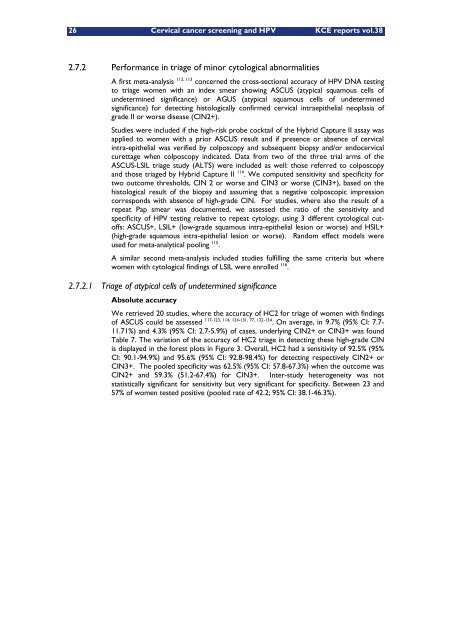Cervical Cancer Screening and Human Papillomavirus (HPV ... - KCE
Cervical Cancer Screening and Human Papillomavirus (HPV ... - KCE
Cervical Cancer Screening and Human Papillomavirus (HPV ... - KCE
Create successful ePaper yourself
Turn your PDF publications into a flip-book with our unique Google optimized e-Paper software.
26 <strong>Cervical</strong> cancer screening <strong>and</strong> <strong>HPV</strong> <strong>KCE</strong> reports vol.38<br />
2.7.2 Performance in triage of minor cytological abnormalities<br />
A first meta-analysis 112, 113 concerned the cross-sectional accuracy of <strong>HPV</strong> DNA testing<br />
to triage women with an index smear showing ASCUS (atypical squamous cells of<br />
undetermined significance) or AGUS (atypical squamous cells of undetermined<br />
significance) for detecting histologically confirmed cervical intraepithelial neoplasia of<br />
grade II or worse disease (CIN2+).<br />
Studies were included if the high-risk probe cocktail of the Hybrid Capture II assay was<br />
applied to women with a prior ASCUS result <strong>and</strong> if presence or absence of cervical<br />
intra-epithelial was verified by colposcopy <strong>and</strong> subsequent biopsy <strong>and</strong>/or endocervical<br />
curettage when colposcopy indicated. Data from two of the three trial arms of the<br />
ASCUS-LSIL triage study (ALTS) were included as well: those referred to colposcopy<br />
<strong>and</strong> those triaged by Hybrid Capture II 114 . We computed sensitivity <strong>and</strong> specificity for<br />
two outcome thresholds, CIN 2 or worse <strong>and</strong> CIN3 or worse (CIN3+), based on the<br />
histological result of the biopsy <strong>and</strong> assuming that a negative colposcopic impression<br />
corresponds with absence of high-grade CIN. For studies, where also the result of a<br />
repeat Pap smear was documented, we assessed the ratio of the sensitivity <strong>and</strong><br />
specificity of <strong>HPV</strong> testing relative to repeat cytology, using 3 different cytological cutoffs:<br />
ASCUS+, LSIL+ (low-grade squamous intra-epithelial lesion or worse) <strong>and</strong> HSIL+<br />
(high-grade squamous intra-epithelial lesion or worse). R<strong>and</strong>om effect models were<br />
used for meta-analytical pooling 115 .<br />
A similar second meta-analysis included studies fulfilling the same criteria but where<br />
women with cytological findings of LSIL were enrolled 116 .<br />
2.7.2.1 Triage of atypical cells of undetermined significance<br />
Absolute accuracy<br />
We retrieved 20 studies, where the accuracy of HC2 for triage of women with findings<br />
of ASCUS could be assessed 117-123, 114, 124-131, 77, 132-134 . On average, in 9.7% (95% CI: 7.7-<br />
11.71%) <strong>and</strong> 4.3% (95% CI: 2.7-5.9%) of cases, underlying CIN2+ or CIN3+ was found<br />
Table 7. The variation of the accuracy of HC2 triage in detecting these high-grade CIN<br />
is displayed in the forest plots in Figure 3. Overall, HC2 had a sensitivity of 92.5% (95%<br />
CI: 90.1-94.9%) <strong>and</strong> 95.6% (95% CI: 92.8-98.4%) for detecting respectively CIN2+ or<br />
CIN3+. The pooled specificity was 62.5% (95% CI: 57.8-67.3%) when the outcome was<br />
CIN2+ <strong>and</strong> 59.3% (51.2-67.4%) for CIN3+. Inter-study heterogeneity was not<br />
statistically significant for sensitivity but very significant for specificity. Between 23 <strong>and</strong><br />
57% of women tested positive (pooled rate of 42.2; 95% CI: 38.1-46.3%).

















